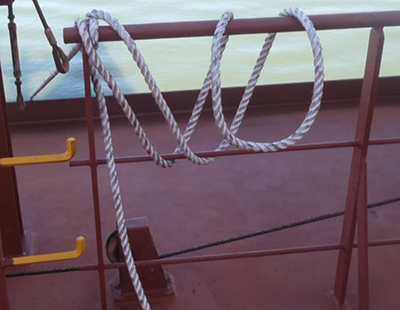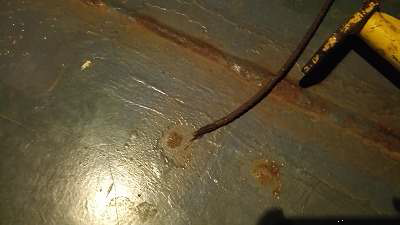The purpose of this marine notice is to bring to the attention of vessel owners, operators, masters, port authorities, terminal operators and persons boarding and disembarking vessels the potential hazards and risks associated with accommodation ladders rigged with unapproved or inadequate secondary means of support arrangements.
Marine Order 12 (Construction – subdivision and stability, machinery and electrical installations) 2016 (MO 12) provides regulation for access to vessels in port.
The master of a vessel is required by section 24 of MO 12 to ensure that the means of access complies with certain requirements. Section 23 of MO 12 requires persons boarding or leaving a vessel to use the means of access provided or identified by the master.
SOLAS regulation II-1/3-9 references the means of embarkation and disembarkation ships and MSC.1/Circ1331 provides guidelines for the construction, maintenance and inspection /survey of means of embarkation and disembarkation.
Although there are no requirements under MO 12 or SOLAS regulation II-1/3-9 for the rigging of secondary means of support to accommodation ladders and no standards in MSC.1/Circ1331 for the construction, maintenance and operational testing of those arrangements AMSA notes that rigging of a secondary means of support to accommodation ladders, particularly where the accommodation ladder is suspended, has become common practice in some Australian ports.
Accommodation ladder secondary means of support arrangements
AMSA has observed that secondary means of support arrangements have consisted of:
- steel wire, synthetic or natural fibre ropes tied or otherwise connected to the accommodation ladder and a part of the vessel’s structure;
- synthetic or natural fibre rope roved through pulley blocks and connected to the accommodation ladder hoisting arrangements or part of vessel’s structure;
- Steel chains or wire ropes with or without a bridle connected to a part of the vessel’s structure or suspended from the vessel’s stores crane or bunker hose davit.
Hazards associated with accommodation ladders rigged with unapproved or inadequate secondary means of support
AMSA has noted in many cases that the secondary means of support arrangements are inadequate for their intended purpose and in fact introduce unacceptable hazards and risks.
Some secondary means of support arrangements have been found to have inadequate load bearing capacity because:
- they are connected to vessel’s cranes or davits with insufficient SWL;
- they are fixed to non-load bearing parts of the accommodation ladder and vessel structure;
- the tensile strength of ropes, wires, pullies and fittings is inadequate.

Unapproved secondary means of support tied to non-loading bearing part of accommodation ladder and vessel structure
Some arrangements are not easily adjustable and add a further risk to safety when the accommodation ladder is lowered or raised to compensate for draught changes or due to tidal variation.
There are often no policies, procedures or instructions contained in the safety management system for the use and maintenance of the secondary means of support arrangements and crew have been unable to demonstrate proficiency in the use of these arrangements.
Incidents and accidents involving secondary means of support arrangements
A seaman suffered a serious eye injury after being struck in the face by a natural fibre rope, which was being used as a secondary means of support. The seaman was lowering the accommodation ladder but neglected to disconnect the rope, which parted under the weight of the accommodation ladder and recoiled violently.

Parted wire from unapproved secondary means of support
There has been several incidents reported to AMSA of the accommodation ladder being rigged so as to be supported by only a secondary means of support while persons were embarking or disembarking.
In one case a person on the accommodation ladder was nearly pitched into the sea when it became very unstable as a result of not being supported by the appropriate hoisting wires.
The hoisting wire of a davit crane, which was being utilised as a secondary means of support, parted while ship’s crew were lowering the accommodation ladder to allow a draught surveyor to embark. The davit crane section of parted wire, block hook, the bridle and wire ropes fell onto the accommodation ladder.
In all the above examples the secondary means of support were inadequate to support the weight of the accommodation ladder and therefore only introduced hazards while not providing an additional safety measure.
AMSA position on accommodation secondary means of support arrangements
AMSA does not require the fitting of secondary means of support to accommodation ladders and encourages vessel owners, operators and masters to seek advice from their Administration prior to fitting such arrangements.
AMSA does not object, in principle, to a secondary means of support that is properly designed and fit for purpose. A risk assessment of any secondary means of support arrangements should be undertaken onboard according to the vessel’s safety management system.
Procedures for the fitting, maintenance and operation of the secondary means of support arrangements should be included in safety management system procedures and crew should be inducted and trained in the use of these arrangements.
AMSA will take action as appropriate where such arrangements are in place and are found to pose a safety risk.
shGary Prosser
Deputy Chief Executive Officer
Australian Maritime Safety Authority
November 2017
GPO Box 2181
CANBERRA ACT 2601